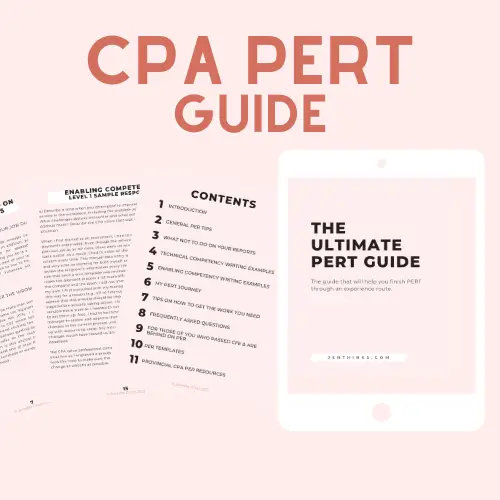My Performance Management (PM) exam is in three days. It is my last CPA PEP exam and my third writing at home. I have not been the biggest fan of writing my exam at home but I got used to it after I wrote two in 2020. The PM module was also the easiest as there was a lot of overlap of content from Core 2 and Finance. I have also gotten a lot better at case-writing as well.
I took a break from reviewing tax technical for CFE to focus on performance management this weekend. I normally write the “what to study” post after the exam but since I had time, I thought I might as well do it while the memory is fresh. I realized this might not be useful if you are writing the PM exam at the same time as me, but hopefully, it will help those of you writing it in the future.
Note, the topics are not listed in any meaningful order and the list is not meant to cover everything that could be tested on your PM exam. Please refer to the CPA Competency Map for exam coverage.
RELATED POST – CPA PEP – What To Expect When You Write Your Exam At Home
Vision, Mission & Values
- alignment between management decision and company’s visions, mission and/or values
- vision: future-oriented, states what its ultimate goal is and how the company will attain its goal
- mission: states the company’s primary reason of existence and how it will achieve its vision without going into specific values
- values: guidelines on how company and employees should act
Common required: discuss how the current vision/mission/values is aligned or misaligned, its strengths and weaknesses, suggest revision
Break-Even / Contribution Margin Analysis
- Break-Even Sales = Fixed Cost / CM (or Gross Margin %)
- Targeted Sales = Fixed Cost + Targeted Profit / CM (or Gross Margin %)
Common required: perform quantitative analysis to find break-even price/quantity etc, states assumptions used in calculation, states the results, states variables that could change the results, make a recommendation
Cash Flow Statement
Common required: perform quantitative analysis to project cash flow, states the results, states variables that could change the results, make a recommendation
Pricing Strategies
- demand-based pricing: priced based on demands, elastic and inelastic demands
- cost-based pricing: priced based on how much it costs to make, e.g., full absorption
- market-based: priced based on the market price
- price bundling: selling several products/services as one product with a lower price than separate
- price skimming: the price is higher initially then decrease over time, e.g., cell phones
- transfer pricing policy: cost-based, market price or negotiated transfer price
Common required: discuss the pricing strategies possible and recommend the best option supported by case facts; discuss the current transfer pricing policy and suggest a better way supported by case facts
~ More CPA Posts ~
CPA PEP Core 1 – How to Study for the Module and the Exam
CPA PERT – Ultimate Guide on How to Get Your First Experience Report via EVR Approved
CPA PERT – Enabling Competencies Examples
Densmore for CPA PEP – Are The PEP Essentials Packages Worth It?
CPA PEP Module – Regular Module or Extended Module?
Risk Management
- operational risks due to lack of internal controls or environmental reasons
- fraud prevention analysis
- use WIR format
Common required: identify risks + explain implications + suggest a mitigation strategy
Capacity Management & Profit Maximization
- given a capacity constraints, advise the optimal product mix/production schedule
Common required: perform CM quantitative analysis then suggest product mix/schedule that maximizes profit (most common)
Outsourcing vs. In-House
- pay attention to shared costs & sunk costs (do not matter), opportunity costs (need to be taken into account)
- make sure to evaluate qualitatively and make an overall recommendation
Common required: compare the costs to outsource against in-house and also look at them qualitatively before making a recommendation
Special or One-Time Order
- if operating at capacity, make sure to include opportunity costs
- if not operating at capacity, minimum price = costs to make (but depends on qualitative factors)
Governance Structure Analysis
- understand what is a good governance structure (e.g., regular meeting, an odd number of members, members with relevant experiences including a finance-savvy member, no conflict of interests, long rather than short terms etc.)
Common required: evaluate the current board of director’s structure, explain implication and make suggestion
Internal & External Environment Analysis
- SWOT: Strengths & Weaknesses (Internal) Opportunities & Threats (External)
- PESTEL: political, economical, social, technological, environmental & legal
- identification + implications/siginificance supported by case facts
Common required: perform SWOT or PESTEL analysis and make a recommendation on strategic direction (PESTEL) or lead to a selection of KSF (key success factor – SWOT)
Process Improvement Techniques
- lean management (elimination of all non-value-added process): JIT, activity analysis and 0 defects approach
- Total Quality Management (TQM): customer-focused management technique by improving processes and holding everyone accountable
- management should be motivated to follow these techniques
- WIR format
Common required: suggest ways to make process improvement by applying process improvement techniques
Performance Measurement Frameworks
- Balanced scorecard (BSC): financial, internal process, customer and learning and development, should tie into KSF
- Key Performance Indicator (KPI): should motivate management and increase shareholder value
- Key Success Factor (KSF): after SWOT, measurements related to KSF can be developed to be used to evaluate how the company is performing
- Bonus System: managers should be motivated by the bonus plan to act in the best interests of company
- a good performance management system is holistic, measurable, motivate management to align with the company’s strategy
- know how to apply the same assessment to non-for-profit (e.g., focus on resource utilization and stakeholders)
Common required: evaluate current performance management system by discussing the issues before making suggestions (e.g., BSC); identify KSFs and explain their significance and suggest measurable metrics
Variance Analysis
- [AQ x AP] [AQ x SP] = price variance
- [AQ x SP] [SQ x SP] = usage/quantity variance
Common required: calculate and explain the variances, identify and explain potential causes
Corporate Social Responsibility (CSR)
- what is CSR: company’s ethical responsibility to all stakeholders (employees, shareholders, customers, community)
Common required: analyze the CSR issues supported by case facts, states implications and make a conclusion
Quantitative Analysis
- NPV, IRR, profitability, ROI (CM/Investment)
- Net Advantage to Leasing (NAL) formula
- states assumptions, results, opportunity costs + recommendation based on quantitative alone
Common required: to evaluate a proposal or opportunity quantitatively
Ethical & Privacy Issues Related to IT
- use WIR analysis to identify issues, explain implication and make suggestion
Common required: identify and analyze issues for a potential new system/software and make a suggestion
Financing Sources
- find out how much financing is required then discuss the potential sources of financing before making an improvement
Common required: determine how much is required and make suggestion on how to finance
Costing Techniques
- allocation base used for costing should drive the cost as it affects profitability (skewed)
Common required: evaluate the current costing system, explain why it is or is not good before making a suggestion
Ratio Analysis
- profitability, efficiency, liquidity & leverage
- calculate the financial ratio, discuss the results (by comparison) and identify causes
Common required: compare current year’s result to prior year and/or industry benchmarks
Responsibility Centres
- revenue, cost, profit and investment centers
- management should be evaluated based on factors they have control over
Common required: identify the type of responsibility center the division is and support decision with case facts before making suggestion on how to evaluate performance


